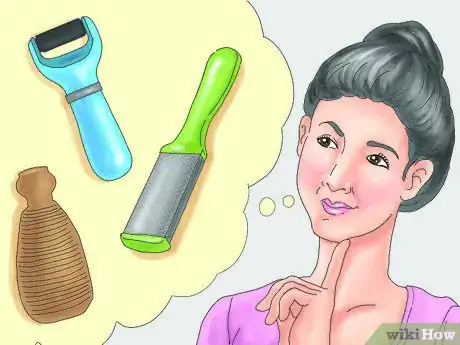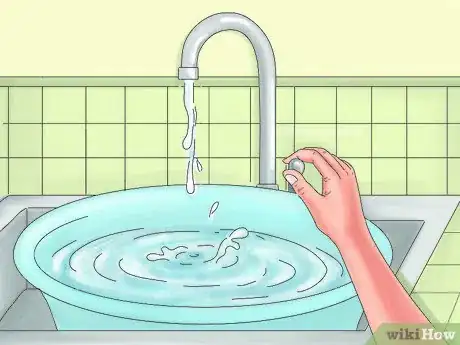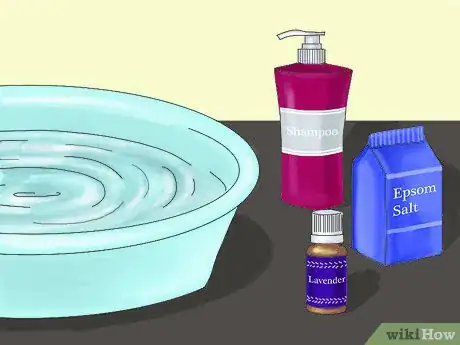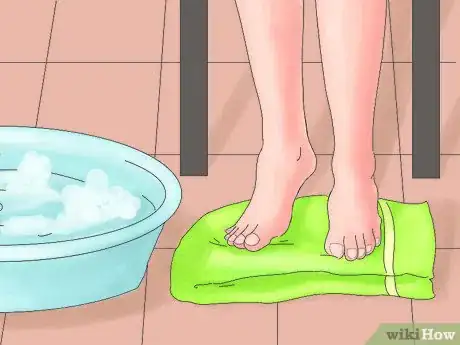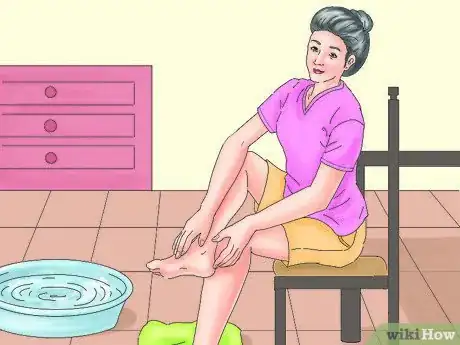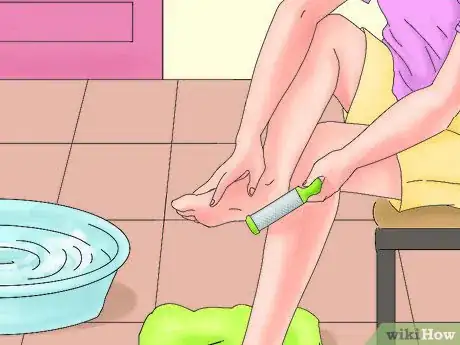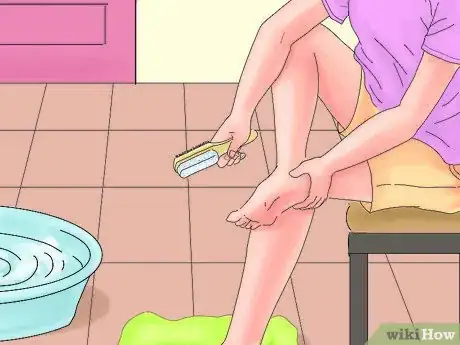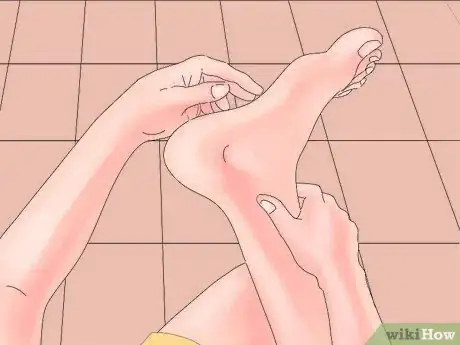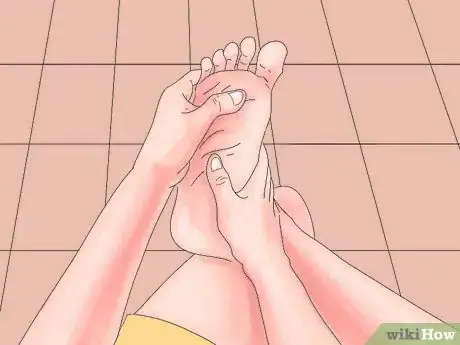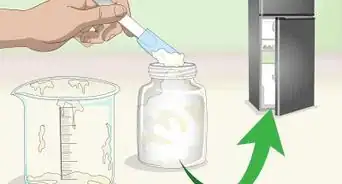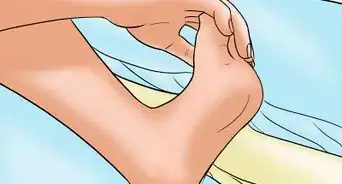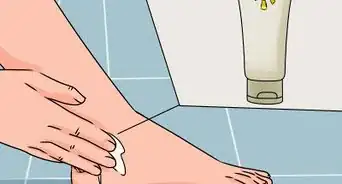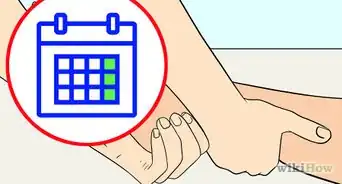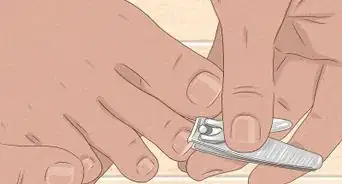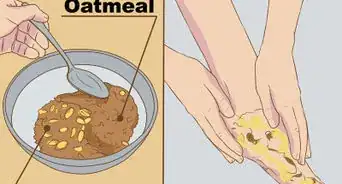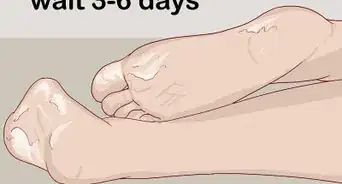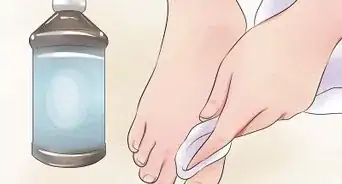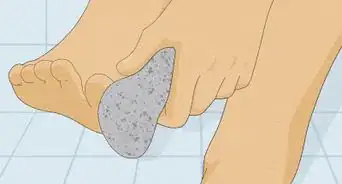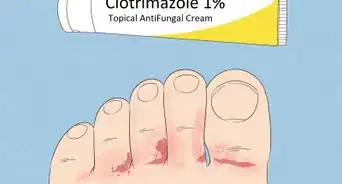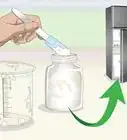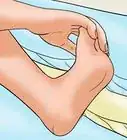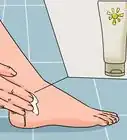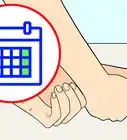This article was co-authored by Miguel Cunha, DPM. Dr. Miguel Cunha is the founder of Gotham Footcare and is a podiatrist based in Manhattan, New York. Dr. Cunha is a foot and ankle surgeon with experience treating a wide array of foot and ankle conditions from minor problems to complex reconstructive foot and ankle surgery. Dr. Cunha received his DPM from the Temple University School of Podiatric Medicine and completed his residency as the Chief Resident at the Washington Hospital Center and Georgetown University where he specialized in lower extremity trauma, diabetic limb salvage, and reconstructive surgery of the foot and ankle. Dr. Cunha is a member of the American Podiatric Medical Association, the New York Podiatric Medical Association, the American College of Foot and Ankle Surgeons, and is board certified in Podiatric Medicine.
There are 8 references cited in this article, which can be found at the bottom of the page.
This article has been viewed 388,195 times.
Callused feet and dry, cracked heels are unattractive and can collect dirt. You want to show off your youthful, soft feet, especially in the summer. To keep your feet looking and feeling healthy, you may want to use a foot scraper to get rid of unsightly calluses and corns.
Steps
Preparing to Use Your Foot Scraper
-
1Consider other ways to remove dead skin.[1] You may want to first consider the various alternatives there are for removing the dead skin from your feet before choosing to use a foot scraper. For instance, you might want to use a tool that won't be as rough as some foot scrapers are, or you might want something stronger in order to get rid of very thick callouses.[2]
- Use a foot scrub.[3] This is the safest option for your feet because there is no risk of friction-related injuries. There are many specialized exfoliating scrubs available at most stores. All you do is rub the foot scrub over your feet to be rid of dead, dry skin.
- Another way to safely soften your feet and get rid of cracked or dead skin is to use ceramic stones made for exfoliating. These stones, like a foot scraper, usually have both rough and finer sides. However, these ceramic stones can be safer to use than foot scrapers, especially for diabetics.
- Consider using a foot shaver. Shavers are often made of stainless steel and are intended for severely thick or dried calluses. They actually shave off layers of skin to get to the softer, newer skin underneath. Know that you can damage your skin if you make a mistake while using the foot shaver, perhaps even leading to infection. You can usually get a foot shaver/razor at any drug store for around $10-$20.
-
2Select a foot scraper. There are many types of foot scrapers available that you may want to check out. While the most common is made with a plastic or wood handle and features a double-sided scraper, they also come in clay, glass, metal or electric forms. Decide which type will make it easiest for you to pamper those beautiful feet.
- Most foot scrapers have one side that is rougher than the other to help remove corns or thicker calluses. You can also use the rougher side first and follow up with the finer grained side for buffering your skin.
- Electric foot scrapers or callus removers are similar to over-the-counter microderm-abrasion tools. You can often get professional results with these durable tools. While the electric foot scraper can give you soft feet quickly, easily and efficiently, know that many of them have parts that must be replaced regularly—such as round emery-board discs. Be sure to stock up on these parts.
- You can also get an easy-to-clean and sterilize glass foot scraper or file for scraping thick skin off your feet. These tools can be boiled or soaked in disinfectant to keep the non-porous surface clean. Be sure to get a glass scraper that is thicker so it won't break as easily.
- A clay foot scraper is safe for your skin and not as harsh as some other scrapers can be. It is a tool traditionally used in Asian countries.
Advertisement -
3Get some pumice. Many people prefer to include a pumice rub after foot scraping for extra soft feet. If you choose to finish with pumice, you will want to find a stone attached to a plastic or wood handle so it is easier to maneuver. You can also use pumice in its natural state, of course, if you prefer that.
-
4Prepare a basin of water. Any container will do as long as your feet can be submerged into it. A foot spa basin is not a requirement, though it can be nice. You will want the water in the basin to be as hot as you can stand without burning your skin.
- Soaking your feet will soften any calluses or thick skin, making it easier to remove with a pumice stone or a foot scraper.[4]
-
5Add your oils, salts, soap and vitamins. Your foot soak can be customized to best suit you. You may want to add shampoo or hand soap to the water in your basin in order to make suds or you may prefer a specific scent to match your mood. Some people use pedicure soaks specifically made for your feet or that contain vitamin A, E or D.
- Consider adding mineral or Epsom salt to the water. Epsom salt, especially, can help treat cracked skin and aching feet. You could also add 1–2 US tbsp (15–30 ml) of apple cider vinegar to the bath, if you'd like.[5]
- You may decide that you want to add some oils to the water to better moisturize your skin. Olive oil, aromatic or essential oils, such as chamomile or lavender, are good choices. Add a teaspoon of these oils to the water and prepare for super soft feet.
- Also consider adding mineral-rich seaweed, marine algae or menthol to the foot soak.
Using Your Foot Scraper
-
1Soak your feet.[6] You now have a warm water bath to soak your feet in. Put your feet in and enjoy. Soak for at least 5 minutes but, ideally, for 15 minutes to get your skin extra soft. You want your feet to be as soft as possible—even wrinkly—before you use a foot scraper to keep your skin from bleeding. .
-
2Dry your feet. Lay a towel next to the basin of water. When you are done soaking your feet, take them out and put your feet on the towel. Dry them gently. You want them to be dry enough to use the foot scraper effectively but moist enough to stay soft.
-
3Feel for rough spots. Now that your feet are softer after the soak, check the skin for areas that are callused. Run your hands over your foot, paying close attention to parts of the foot often affected by thick skin, such as the ball of the foot, heel, top of your toes and foot sides. Once you have determined which areas to work on, you can start using the foot scraper.
-
4Use the foot scraper. Pick up one foot and place it on the opposite knee to get it into a good position for using the foot scraper. Flex your foot, stretching, so the ball of your foot sticks out more. Hold the scraper against the foot and use a downward motion to scrape off any thickened skin. Continue scraping the skin until all areas of the foot are smooth.
- Use very gentle scrapes—it's best if you remove the thickened skin gradually over a few sessions to ensure you aren't too aggressive with your feet.[7]
- Use the foot scraper where you determined you have rough skin. Avoid tender or very soft areas.
- Sometimes only a little bit of skin will come off when you use the scraper. This could be because there is not much thickened skin in that area. If you can tell there is still hard skin, however, try the other side of the scraper or use a foot shaver/razor.
- Use the foot scraper on the other foot by placing the new foot onto the opposite knee.
-
5Use a pumice stone. Pumice is a lightweight, volcanic rock that is very porous and useful as an exfoliator. After you use the foot scraper, a pumice stone can be particularly effective at sloughing off any remaining dead skin cells. Apply lotion or oil to foot or the pumice stone to help it slide across your skin easier. Scrub the whole foot, using circular motions.[8]
- Pumice stones are rough and can be harsh on sensitive skin. If so, don’t press so hard on the skin. Do it lightly.
- Repeat on the other foot.
Finishing Up Your Feet
-
1Check your feet. Run your hands over your feet and make sure your skin is smooth. Check the areas you noticed needed work before you started using the foot scraper. If you still feel some rough patches, go back and reuse the foot scraper and pumice. You should definitely notice a difference.
- Do not overdo it. You can scrape too much, causing redness and irritation or cuts.
-
2
-
3Massage your feet.[11] Massaging is very good for your feet as well as the newly exposed skin. It increases blood circulation, relaxes muscles and relieve pain. Do one foot at a time and keep massaging for at least one minute each.[12]
- Grasp the foot in both hands. Use both hands to squeeze the foot near the toes. Gradually move up toward the ankle.
- Use both hands to twist the foot lightly in opposite directions. Start at the toes and work up toward the ankle.
- Rub your fingers of both hands along the foot in circular motions. Feel for crevices between bones and joints. Press in and rub those areas.
- You can also use your knuckles along the bottom of the foot. Kneading the skin with your knuckles offers greater pressure and feels great.
Expert Q&A
Did you know you can get expert answers for this article?
Unlock expert answers by supporting wikiHow
-
QuestionHow can I safely use a foot scraper?
 Miguel Cunha, DPMDr. Miguel Cunha is the founder of Gotham Footcare and is a podiatrist based in Manhattan, New York. Dr. Cunha is a foot and ankle surgeon with experience treating a wide array of foot and ankle conditions from minor problems to complex reconstructive foot and ankle surgery. Dr. Cunha received his DPM from the Temple University School of Podiatric Medicine and completed his residency as the Chief Resident at the Washington Hospital Center and Georgetown University where he specialized in lower extremity trauma, diabetic limb salvage, and reconstructive surgery of the foot and ankle. Dr. Cunha is a member of the American Podiatric Medical Association, the New York Podiatric Medical Association, the American College of Foot and Ankle Surgeons, and is board certified in Podiatric Medicine.
Miguel Cunha, DPMDr. Miguel Cunha is the founder of Gotham Footcare and is a podiatrist based in Manhattan, New York. Dr. Cunha is a foot and ankle surgeon with experience treating a wide array of foot and ankle conditions from minor problems to complex reconstructive foot and ankle surgery. Dr. Cunha received his DPM from the Temple University School of Podiatric Medicine and completed his residency as the Chief Resident at the Washington Hospital Center and Georgetown University where he specialized in lower extremity trauma, diabetic limb salvage, and reconstructive surgery of the foot and ankle. Dr. Cunha is a member of the American Podiatric Medical Association, the New York Podiatric Medical Association, the American College of Foot and Ankle Surgeons, and is board certified in Podiatric Medicine.
Board Certified Podiatrist
Warnings
- Don’t get your foot shaved during a pedicure outside of your home. You can get fungal or bacterial infections from dirty foot baths and unsanitary tools.[13]⧼thumbs_response⧽
- If you are diabetic and have peripheral neuropathy, avoid scraping or shaving your feet, as you may not be able to tell if you accidentally scrape your foot too hard. You could cut yourself, and an open sore on your foot can be very serious. See a podiatrist every 3 months for your foot care, instead.[14]⧼thumbs_response⧽
Things You'll Need
- Basin of warm water
- Epsom salt or other bath salts
- Oils
- Moisturizer
- Foot scraper
- Pumice stone
- Liquid soap.
- Newspaper or towel (on the ground to collect the shavings)
References
- ↑ https://www.phillymag.com/be-well-philly/2013/04/10/diy-pedicure-recipes/
- ↑ https://www.medicalnewstoday.com/articles/324909.php
- ↑ https://www.huffpost.com/entry/feet-care_n_5430008
- ↑ Miguel Cunha, DPM. Board Certified Podiatrist. Expert Interview. 22 April 2020.
- ↑ Miguel Cunha, DPM. Board Certified Podiatrist. Expert Interview. 22 April 2020.
- ↑ https://www.huffpost.com/entry/feet-care_n_5430008
- ↑ Miguel Cunha, DPM. Board Certified Podiatrist. Expert Interview. 22 April 2020.
- ↑ https://www.youtube.com/watch?v=xv63OJixJtI
- ↑ https://www.huffpost.com/entry/feet-care_n_5430008
- ↑ https://www.webmd.com/skin-problems-and-treatments/healthy-feet-tips#1
- ↑ https://www.huffpost.com/entry/feet-care_n_5430008
- ↑ http://web.archive.org/web/20081225235304/http://www.marieclaire.com:80/hair/beauty/tips/pedicure-foot-care
- ↑ http://feet.thefuntimesguide.com/2008/06/pedicure_foot_razors.php
- ↑ Miguel Cunha, DPM. Board Certified Podiatrist. Expert Interview. 22 April 2020.
About This Article
To use a foot scraper, start by filling a tub or basin with warm water and soaking your feet in it for 15 minutes, which will soften the skin on your feet. Then, lightly dry your feet off with a towel so they're still slightly moist but not dripping wet. Next, take your foot scraper and gently scrape off any thickened or rough patches of skin on your feet, using a downward motion. Finally, when you're finished, apply lotion to your feet to moisturize them. To learn how to use a pumice stone to make your feet feel even softer, scroll down!

